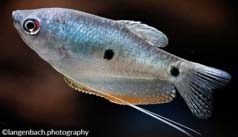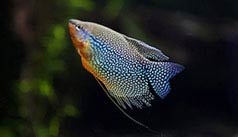

Moonlight gourami
(Trichogaster microlepis)
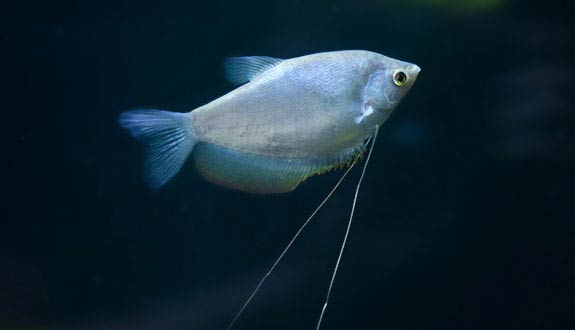
Many thanks to Kyllian!
Alternative species (click on the thumbnail to see the card)
Names
Scientific name
Trichogaster microlepis
Trichopodus microlepis
Osphromenus microlepis
Common name
Moonlight gourami
Moonbeam gourami
Origin

Origin: Vietnam, Thailand
Biotope: Asian
Dimorphism

The male’s long pelvic fins are orange to red
Group

Osphronemidae
Volume

200 L / 44 imp gal / 53 US gal
Water parameters

T°: 26 à 30°C or 79 to 86°F
pH: 6 to 7
Hardness: 2 to 20°dGH
Difficulty

Easy
Size

11 to 13cm (4.4 to 5.1")
Longevity

4 to 6 years
Living zone
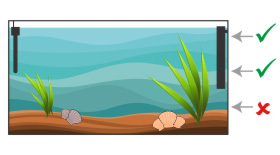
Middle and top
Individuals
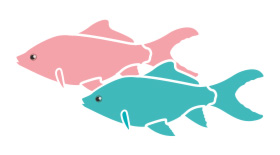
2
Food
How to feed the Moonlight gourami?
Food
How to feed the Moonlight gourami?
The Moonlight Gourami will accept all the food you propose. However, for better physical and mental health, you will offer live or frozen prey regularly (cyclops, artemia, daphnia or mud worms). Note that this Gourami eats slowly: make sure it has taken its meal.
Behavior
What kind of behavior does the Moonlight gourami have?
Behavior
What kind of behavior does the Moonlight gourami have?
Quiet and peaceful in general. It should be noted, however, that each fish has its own character. So, some will be so peaceful that it will come close to shyness, while others may be irritable and agitated. Others will be more balanced. Careful observation during your purchase will help you to distinguish the character of the intended fish.
Gouramis live under surface plants and will spend most of their time in this area.
Males of the same species do not get along very well and are territorial. Females are calmer. Thus, you will avoid putting 2 males in the same aquarium: for a 200 liters (44 Imp Gal or 53 US Gal) aquarium, only one male and one female will suffice. Similarly, cohabitation in trio (1 male for 2 females) is not possible because the female not chosen will be assaulted by the couple.
Cohabitation
Who can live with the Moonlight gourami?
Cohabitation
Who can live with the Moonlight gourami?
In general, avoid all other surface species. Too small fish will be considered the next meal. Finally, fish too lively (Molly, Guppy)... or having a tendency to attack the big fins (Barbus Sumatra for example) are not good companions for Gouramis.
Corydoras are not very suitable because they need a less planted aquarium, unlike Gouramis who claim a lush aquarium (see "Its aquarium").
Apart from these few exceptions, relations with other species will be very good.
Breeding
How to breed the Moonlight gourami?
Breeding
How to breed the Moonlight gourami?
The breeding protocol is the same as for all Gouramis.
If you want to raise the fry, plan an aquarium reserved for their breeding. It will have to contain many plants and floating plants.
Introduce the pair into the breeding tank and prepare them for spawning. For this, feed them with live prey. Also increase the temperature to at least 27°C or 80°F and make water changes. This should trigger spawning in a few days.
The male will build a nest of foam on the surface and attract the female. The pair will position themselves under the nest and adopt the typical embrace of this family of fish. Spawning can last up to 2 hours and include 500 to 1000 eggs for the best breeders. The male will collect all the eggs in the nest.
Remove the female just after laying, because the male will now protect the nest from any intrusion, including that of the female.
The incubation lasts 1 or 2 days and the fry swim freely after 2 more days. From this point, remove the male as well. Note that fry are very sensitive to changes in water parameters. It is recommended to change the water only once they have reached a little more than one centimeter or 0.4 inches.
Fry food: infusoria (to be distributed 3 or 4 times a day for the first 15 days), then artemia nauplies, dried food powder...
Its aquarium
Which aquarium for the Moonlight gourami?
Its aquarium
Which aquarium for the Moonlight gourami?
Due to its beautiful adult size, this fish will need a minimum of 200 liters or or 44 Imp Gallons or 53 US Gallons for its well-being.
The Gourami will be more comfortable in an aquarium that resembles its natural environment. Thus, a dense vegetation cover and soft lighting will be particularly appreciated. Be careful though because the fish tends to chew tender plants. Choose rather robust plants with thick leaves and bet on the species of surface (Pistias, lenses of water, Egeria, Cerato, Hydrocotyle... that you will let float).
Do not put too much current on the surface because this fish normally lives in stagnant water. It is therefore advisable for the brewing to take place elsewhere in the aquarium, or to «break» the current against a window of the tank.
Although the Moonlight Gourami is quite tolerant with water parameters, they must be stable. When you make your water changes (20 to 25% each week), make sure that the new water has the same parameters as the aquarium.
Good To know
Find all additional information!
Good To know
Find all additional information!
Its beautiful silver colour earned him its nickname «Moonlight Gourami».
It is eaten in Asian countries.
Like all Gourami, this fish can breathe the ambient air. This is possible thanks to an organ it has developed in its home environment. Indeed, it lives naturally in stagnant and little oxygenated waters. It had to find na way to breathe other than in the water. It therefore developed a complementary respiratory organ: the labyrinth. Thanks to him, the Gourami can survive in extreme conditions and even a few hours outside the water (in a certain humidity all the same).
Its ventral fins are much longer than other species of Gouramis. In the male, they turn from orange to red during the breeding season.
Yours photos!
Comments
Sort by:
Please login to post comments
